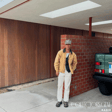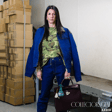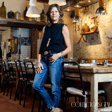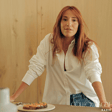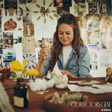Rob Moffat's Pandemic Pivot
00:00:00
Speaker
I can afford a retail space at the time and you know is the beginning of the lockdowns and the pandemic and i was like. How can i do this and how can i make this pivot and so you know people were doing all these outdoor activities especially in los angeles and farmers markets were a big thing so i came up with the plant truck so took a basically a food truck rip the top off put a greenhouse on and i would travel around los angeles to all the different farmers market selling house plans. What's going on everybody and welcome to collector's gene radio. This is all about diving into the nuances of collecting and ultimately finding out whether or not our guests have what we like to call a bunch for listening and please enjoy today's guest on collector's gene radio.
From Nursing to Plant Design
00:00:54
Speaker
Today we're hearing from plant designer and rare plant collector, Rob Moffat. He founded his company House Plant just a few short years ago on the rare occasion that he didn't previously collect plants at all. Fast forward a few years and Rob's a go-to in the plant design world, sourcing and collecting rare plants for some of the biggest interior design projects.
00:01:13
Speaker
Now these aren't just your typical nursery plants either. Rob sourcing from some of the most esteemed plant collectors, estates, and even plants that come from the jungles of Brazil and Southeast Asia. It's not just about finding the right plant though. Rob is known for manipulating roots to be more architectural and displaying them in more organic materials and vessels. This is a first for the show, so without further ado, this is Rob Moffat for Collectors Dream Radio. Rob, welcome to Collectors Dream Radio.
00:01:42
Speaker
Thank you. Thank you for having me.
Podcast Debut and Plant Journey
00:01:44
Speaker
So Douglas Friedman connected us and I'm so excited because I believe it's a first maybe for both of us, yeah you know, my first plant designer and plant collector and your first podcast, right? Yes, it is. Awesome. Well, couldn't be more excited to have you on and it's such a new area for me to learn about. And I'm really excited to dive into everything rare plants and plant collecting and designing and all that. Definitely.
00:02:11
Speaker
So you kind of fell into all of this a bit haphazardly, I would say. I mean, you were working in the medical field and you began volunteering in the plant world, eventually launching the house plant, your company. And you started with a mobile greenhouse, which by the way, is one of the coolest things I have ever seen. I mean, the car had a greenhouse roof on top of it.
00:02:32
Speaker
Yeah, thank you. So it was during the beginning of the pandemic. I was ah had been a nurse for 12 years and I was getting to the point where I wanted to start exploring more of the creative side of my brain and you know had started working at a friend's plant shop for fun on my days off from the hospital and after a while he was like, okay, like yeah you're good, go do this. So I you know couldn't afford a retail space at the time and it was the beginning of the lockdowns and the pandemic and i was like how can i do this and how can i make this pivot and so you know people were doing all these outdoor activities especially in los angeles and farmers markets were a big thing so i came up with the plant truck so took a basically a food truck
00:03:17
Speaker
rip the top off put a greenhouse on and i would travel around los angeles to all the different farmers market selling house plants so that's kinda how i got my my start with a tiny little mobile shop and didn't have to have like a actual you know brick and mortar retail footprint.
00:03:33
Speaker
And I mean, it's your first day with this truck. ah Did you have
Learning on the Go: Plant Truck Adventures
00:03:38
Speaker
clients lined up? I mean, what did what happened? and Not at all. um I kind of went into this blindly. I didn't really know how I was going to go about it. I didn't really know much about the permitting. you know there's you know There's food trucks, there's some retail vendors, but there's not there's not many plant trucks out there. There are a couple. I found one in Paris, there was one in New York.
00:03:58
Speaker
I think I found every plant truck that existed and I kind of did my own version of that. But there weren't many people that were you know willing to give you the ins and outs of how they figured it out. So it was kind of something I just kind of had to figure out on my own. I think my first day out, I actually went to a parking lot for a Mother's Day opening at Fred Siegel.
00:04:19
Speaker
Oh, amazing. That's great. I'm sure you had a ton of great clients there already. Yeah, it was great. I mean, the first day I think it was mostly, you know, friends and family and, um, you know, curious people going into the store, um, that would stop by. So I think the truck was a kind of a neat, it was very different and unique. So people kind of it piqued their interest there. What do you love so much about plants that made you make this jump and ultimately become a go-to in the industry and a collector?
Creative Fulfillment in Plant Design
00:04:48
Speaker
Yeah, um I think I originally got into plants out of like ah ah more of the creative side. Like I guess that's kind of how I fell into plant design. But I think just my background in healthcare and caring for people, um it kind of translates over to caring for plants in a way. And plants kind of allow you to get lost in them. I think I imagine how it is for a painter painting. When I'm working with plants, I'm away from my phone. i'm kind of in my own world and it allows me to just connect with nature and kind of like, especially living in a city, more more in like ah an urban way, I guess. I want the listeners to understand a little bit more about why what you do is so special, right? These these aren't just plants from your typical nursery. You're sort of some of the rarest plants in the world. Some even belong in the jungles of places like Brazil and Southeast Asia.
00:05:40
Speaker
Yeah. So I originally with the truck, I had started, um, just with, you know, basic house plants that you could get at any nursery. And then I started, uh, finding clients at these farmers markets and you know, Beverly Hills or Brentwood or the Palisades. And I noticed that there was an interest for the more unique or, um, you know, with the antique vessels and the interesting plant pairings. So I started, especially in Los Angeles with the climate we have, we kind of have access to some really beautiful,
00:06:09
Speaker
you know old specimen plants and I started started you know finding different collectors, other plant collectors and slowly buying you know something I could afford to afford at the time and re-styling it and you know selling it to a client. So in the beginning I never really look to myself as a collector but more of like this is what i need to do to get to the next level of business and you know it kind of just let me down this path of overtime like actually being a collector myself.
Sourcing Rare Plants and Bonsai
00:06:39
Speaker
And you collect a rare bonsai right yeah i do rare bonsai is kind of the foreign plants anything with like very unique shape or age i think the more strange or weird the better.
00:06:52
Speaker
And I love going to you know an old nursery that's a little run down and I go right for the back of things that are overlooked. And i those were those those are where all the like hidden gems are that you can kind of you know give a second life to or restyle and shape the way that I find interesting. So that's one thing that I really love about this world I'm in now. What makes Bonsai's so special to you and how do you go about sourcing them?
00:07:17
Speaker
um I love the story that they all have. Like I said, I'm meeting with these other plant collectors who've been in the industry for, you know, 30, 40 years and i'm fine i'm I'm buying plants that they, like there's one that I i bought that was ah from a collector who remembered going to a plant trade show with his dad, you know, 50 some years ago and buying this plant and I actually bought it off him and restyled it. So i I love hearing the stories of these plants, the stories of the collectors who've been doing this for longer than I've been alive and then knowing that I'm kind of
00:07:53
Speaker
bringing them into my own collection and you know giving them a second life and a second story. And then you know when I sell them to a client, you know I have a lot of really, really interesting, neat clients. So these plants are getting like a second and a third life you know through me, which is really, really fun and exciting for me.
00:08:11
Speaker
Yeah, and I think the other interesting thing is, you know, when you look at the way that people collect a lot of about what they love is how can they also display
Design Collaborations and Plant Displays
00:08:20
Speaker
it, right? How can you display wine artfully, right? And so for you, I i feel like from what I've seen, the new thing that people are really loving when it comes to displaying these plants is Not in your typical pot, right? It's in more of like a rugged, free-form stone that's been carved out and then the plant sits in that. Is that kind of what the market is after? Yeah, I'm always trying to find, you know, what hasn't been done before, what's new, or do my take on what has been done. And then I'm finding that or I found that working with interior designers
00:08:52
Speaker
has been a big opportunity for kind of pushing those limits because they're always on the forefront of design and trying to figure out what hasn't been done before. So kind of the way I got started in that world was going and offering my plants for free to big design showrooms like Holly Hunt and Nicky Kiyo and some places like that. And, you know, interior designers would find me there. And then also the collaborative process, too, with, you know, them bringing me into these clients homes, they're ready for the photo shoot,
00:09:22
Speaker
Usually the plants are the sort of the last thing to come in. Sometimes the house is still looks to me like it's still under construction and photoshoot is happening next week. So I have to think quick on my feet and do these plant and vessel pairings pretty quick. But it also allows me to sort of grow and figure things out as I go.
00:09:42
Speaker
Is there a bonsai species that you find to be more rewarding to collect? Not necessarily in a monetary side of things, but just something that really gives back, right? There's certain brands of certain people that love to collect certain things that they always go back to, that just they feel like they get the the most out of just from enjoyment levels. Is is there something like that with bonsai species? so i'm fine i mean i'm I'm still pretty new in this whole world. I've been doing a total of about three years now in terms of a business um and collecting for just a little bit longer than that. But I'm finding that I'm going through phases and cycles of what what species I like.
00:10:21
Speaker
I really like um the manipulation of a certain plant-like species. ah My favorite, I would say, is this, it's a ficus pedilaris, and then manipulating their roots or their their branches with, you know, wires or having the the roots growing over a rock and placed in a vessel. So I like plants that kind of allow you to manipulate them over time, and that makes them, I think, all that more special and sort of one-of-a-kind collector pieces.
00:10:51
Speaker
Do all the plants that you source and collect need cared for differently or is there a standard practice? There's definitely standards. So with my business, we have a whole maintenance program.
00:11:03
Speaker
because a lot of the more interesting, special, you know, rare and expensive plants need a little bit more specialized care. There are like the standards of plant care when it comes to, you know, watering and fertilizing. Well, for fertilizing can be a bit different, but watering pest control, the type of pests you might see, especially when you're bringing these plants that, you know, might be from the jungles of Brazil or, you know, Madagascar, and we're bringing them into our, you know,
00:11:30
Speaker
dry apartments or homes um so we're we're taking them out of where they should be and putting them in our homes where they look beautiful so every plant is a little bit different but the care and the basics um i think can be taught pretty simply. And the maintenance side of your business is is that you going to these clients homes on a frequent basis to check on them to take care of them.
00:11:53
Speaker
Yeah. We, we service the Los Angeles area and we have maybe like 30 to 40 clients that we see on a weekly basis where we, after we do the install, we continue with our, our maintenance team and we go in and make sure everything is, you know, free of pests and you know, looking good and you know, there's no issues.
Trends and Misconceptions in Plant Design
00:12:11
Speaker
So yeah. So your plants have been featured in many notable interior design projects. How do you work with designers and collectors to ensure that your plants fit perfectly within their spaces. That has been the most exciting thing for me. Two years ago, I was sitting on the side of the street in a hot truck trying to sell plants, and then I sort of pivoted the business and you know really was pushing to what I wanted to do, which was more of like the plant design and working with designers.
00:12:41
Speaker
So when I think I think ah probably Nikki Kiyo and Amy and Todd were the first designers that I sort of worked with and then just sort of being a little part of some of these design projects as you know last for years and plants are kind of the last thing to come in so having them trust me with you know my taste and vision to work alongside theirs has been really neat. So the process of that has been really interesting and I'm still kind of learning as I go. Every designer is different, their process is different, but I think them having the house plant as a resource for you know these additional touches to their their design project has been a really neat kind of marriage of design. Yeah, absolutely.
00:13:26
Speaker
And you know it kind of seems like from the photos that I've seen and the work that you've done that a lot of times one plant makes more of a statement than multiple plants. And as a collector, is there ever a struggle there, you know leaving one plant as the focal point versus showcasing several rare plants in a singular space? because i you know The trend I feel like for a long time with people who maybe didn't know what they were doing is they were just going to the store and buying a million different pots and just putting them on the ground and it just looked like you know they were trying to start their own jungle in their own homes and it wasn't the most aesthetically pleasing.
00:14:03
Speaker
Yeah, I mean, I i think this is gonna be, I mean, like I said, I'm so new to the, you know, design world in general, let alone the plant design world. But you know, like, historically, back in the 70s, we had these built in planter boxes in these mid century, modern homes with, you know, huge trees and palms. And then there was, you know, back in the, I think, probably like,
00:14:24
Speaker
early two thousands there was like the fiddly fade that started showing up in the design magazines and now you see them everywhere um so i think there's definitely and then most recently the black olive is in every design magazine everybody wants it and they're kind of a difficult tree to care for so i'm really happy people move away from that one right now what i really like to do is the smaller more structural pieces these like you know with the architectural branches And it it's interesting that I kind of have my plants in these magazines, so I i like to think that I have a little bit of say in where this trend is going. So I'm actually curious where where it will go because I want to keep up with it and maybe set some of those trends. What are the common misconceptions that people have around plant design and collecting that we could just debunk right here?
00:15:13
Speaker
Um, set it and forget it that plants are living things. Um, they can go into shock when they change environments, especially with the more interesting ones. They do require a little bit more care and plants need light, you know, and I think those are some of the biggest misconceptions as people are used to their palms or their fiddle leaf where they kind of just like set it in the corner and leave it. I think when you start to get into the more interesting and exotic species, there is a little bit more care involved. And you know that's one thing that some people may be frowned upon with
00:15:49
Speaker
you know, the some of these plants in these magazines is a lot of times these are used for the photo shoot and they don't, they maybe not live in this dark bathroom um or wherever they're seeing them. So I just, that's one thing that I think I would like to set the record straight is sometimes the plants that you see in a photo don't live there long-term.
00:16:08
Speaker
Right. i'm I'm sure hanging eucalyptus from a shower head is your biggest nightmare. Totally. As with most of us collectors, an item must go through this mental checklist that we have in order for us to quote-unquote pull the trigger. For you, what does it take for you to add something to your personal collection and does it differ from what gets added to houseplant?
00:16:32
Speaker
I'm just recently getting to the point where I'm collecting for my personal collection. At my house, I only have two plants and one of them is just a big money tree stump. And then the one the other one's more interesting, but I don't like to keep plants at my own house because I am with plants and everybody else's plants most of the day. So when I come home, I like a simple plant or two to take care of. And also those ones are also for sale.
00:16:58
Speaker
Um, my, my bigger collector pieces that are not for sale, I keep in the showroom because they're that impressive. Um, and I, I think the big ones help sell the small, the smaller versions of that as well. Yeah, for sure. And you know, besides just knowing what you're looking at, is there a way to confirm the, you know, the rarity or the provenance of some of these plants? Do you have to buy the dealer? Yeah, I think I'm just, I'm learning that over time.
00:17:24
Speaker
You know, a couple of years ago, the, you know, the breaky chitin, which is an Australian bottleneck tree, was kind of this rare plant and everybody wanted it. And then I started sourcing more and more and using them and things. And then they became, they're becoming more and more common and a lot of people are starting to sell them. So it ah it also depends on how things are reproduced. During the pandemic, there was this whole thing with the variegated monstera, where it was, you know, the, you know, typical like,
00:17:51
Speaker
Swiss cheese, Monstera plant that you would see it like a Trader Joe's or, you know, kind of any plant store, but it had this white sort of white leaf variegation to it. And that was um considered very rare. And these were going for thousands and thousands of dollars. so And then these growers kind of caught on to that and they were able to mass produce them. So now you can kind of find them again anywhere. The thing I really like about You know, a rare plant is the age because you get like really interesting branching and these really thick bases and codex. So I think, I think ah for a plant to be rare, quote unquote, I also look at things like age and shape and form.
00:18:32
Speaker
Yeah, absolutely. and How do you determine you know the value of some of these plants? i mean if If someone, you know a collector comes and says, hey, I have this rare plant and you've never seen it before, how do you even go about making an offer to acquire it? To be honest, I'm still learning that. um ah gotten gae on what there's There's two other big plant design companies in Los Angeles. and I've kind of learned you know where i fit in the market i i want to i also want to be fair i don't want to take advantage of clients um
Balancing Collecting and Business
00:19:03
Speaker
so i try to keep my pricing fair but also some of these things do have the age and the the rarity that they do require a higher dollar amount um so i think. Just learning learning overtime yeah yeah make sense.
00:19:18
Speaker
So you mentioned earlier, you know, yeah you only keep a couple of plants at home and of course they're for sale. But as you're just getting started in this collecting world, from what I've seen from a lot of collectors in a lot of different sectors, when you first start out collecting, you kind of just want to buy everything because your interests are so broad and everything's amazing. And what is that, you know, juxtaposition? I always ask this question to new collectors of, you know,
00:19:46
Speaker
You don't want to sell stuff, but you also have a business to fund. And what's that like of keeping and selling and back and forth? I'm learning the balance of that right now. My head of sales, I think has to sometimes take my credit card away. Cause I, if a collection comes up, so basically the way it works for me is i I now have a handful of people that go out and buy full collections of, you know, say somebody who, you know, passed away or somebody who can't care for their, you know, this collection they've been curating over the last couple of decades and they'll go in and buy everything. And then they shoot me a message and say, Hey, I just got this collection in.
00:20:20
Speaker
do you want to come take a look and see what you want first. So I'll go in and I'll pick out anything that I want and then they'll sell the rest in their retail store or anything or to other collectors. So it has been really hard when I see like an amazing collection come up of some of the some things that I've never seen before of that age or what have you and it's really hard for me to not buy everything.
00:20:43
Speaker
And also space. I'm running out of space at my current location. So I think the next step is to buy a plot of land somewhere outside of Los Angeles and kind of have that for when these big collections do come up. I can buy it and stash it and store it and wait until I have the client for it.
00:21:01
Speaker
makes sense. Yeah, it's funny, you know, you see a lot of these big estates and the gardens are always groomed and and everything like that. And I think people don't realize that a lot of these people do collect plants and that there are interesting and rare plants. It's not just, you know, a random hedge or anything like that. Like they have a story and they have a purpose and there's a reason that it's there and that it looks the way it does.
00:21:22
Speaker
Yep. I ah recently, one one of my, one of the neighbors to where my showroom is in Los Angeles, he runs estate sales and he, when I was doing construction on the building, he kind of saw that I had all these antiques and plants and he kind of popped his head in and introduced himself. And just recently, maybe a month or two ago, he came in and he was like, Hey, I have this fabulous home in Beverly
Finding Treasures at Estate Sales
00:21:45
Speaker
She was a plant collector has this amazing stuff you have to come by so he allowed me to come in before the estate sale open to anybody else and Sure enough. She had some plants and some you know vessels that I had to have so I kind of brought my truck up there bought everything and fill it up but yeah, that's where you find some of the best things is these these estate sales you know a random person's backyard in the middle of the desert like i'm always on the hunt for these things i love it before we wrap it up at the collector's gene rundown i'd love to. Understand a little bit more you know you started the house plant based on passion and then you subsequently became a collector because of it. And now that you're a full-fledged collector of this stuff i would love to know how you feel it's help propel your business to where it is today.
00:22:35
Speaker
Well, for me, this was like a passion project and a hobby almost. um I was working as a nurse up until just a year and a half ago.
Passion and Success of House Plant
00:22:43
Speaker
And I kind of cut back there while I was doing this. So for me,
00:22:47
Speaker
it sort of just turned into what it is. And I think, I think there's a lot, especially during the pandemic, a lot of people, a lot of plant shops opened up and a lot of them have since closed. Um, I think the one thing that makes the house plant, what it is, is, you know, my true passion and love for just finding the best of the best and collecting and all the time. I i mean, I'm always on the hunt, always searching for the best. So I think that is one thing that's really helping. You know, there's a couple of, like I mentioned, there's a couple other,
00:23:17
Speaker
You know plant design stores in town and they've been doing it for 40 50 years and you know They have some of the best things and you know, I'm two and a half three years in and I'm starting to build my own collection, too Absolutely. It's it's about having the ah the collector's mentality to to help that move forward. I love it Rob Let's wrap it up with the collector's dream rundown. What's the one that got away? I was a tree when I first kind of got into this, you know, more exotic collecting world that was 40, 50 years old. It was grown over this massive piece of limestone, but it was just out of my budget at the time. Um, so I had to pass on it, but I still think about that one. Where, where was it? Um, it was here in Los Angeles. It was from a collection. I think that, uh, the, the owner had passed away and then one of my brokers here had found it and offered it to me, but
00:24:13
Speaker
Wasn't wasn't the right time. And how does that work? Would you take the piece of limestone with it? Yeah, yeah, the the roots were completely grown up like trained to grow over and attach so I mean you would have to use the jaws of life to get it off of there. And then and then what would you you know what as a plant designer where I'm curious where would something like that go because it it's more structural if it's growing over, you know a limestone a wall or whatever. So usually when you find stuff like this, it's kind of overgrown and gnarly and a little bit messy. So I would use like you know my bonsai tools and wiring to kind of reshape it and style it. And then you know typically I would you know source a vessel, whether it be like a Willy Ghoul or like another piece of stone, and then style it within that as well. Okay. Interesting. How about the on deck circle? So what's next for you in collecting maybe a plant you're hunting after?
00:25:05
Speaker
The plants, I'm just always on the the hunt for plants. I think bigger is where I'm going next. Right now I don't have any heavy machinery, but I'm looking at another space. I'm looking at a forklift. I'm looking at a crane and more help. So once I have those things in place, then I'll be able to go after some of the bigger specimen trees that I'm not able to right now.
00:25:29
Speaker
I love it. How about the unobtainable? So this is one that is just too expensive in a museum, a private collection, it's just complete unobtainable. Take a walk through Huntington Gardens. and they They have they have you know some of the most amazing specimens that you can't find anywhere else. So um I go there for inspiration and yeah, they have some of the the most beautiful plants I've seen.
00:25:54
Speaker
How about the page one rewrite? So if money was no object, and you could collect anything else in the world besides plants, what would it be? Hmm. Two-parter. I think not having the money upfront has allowed me to be really scrappy and figure things out as I go. So i i in the beginning, I really wanted like a big loan or ah figure out a way to dump a bunch of money in this and into this. So I'm actually grateful that I had to figure it out as I went.
00:26:22
Speaker
um to back to your actual question. i think I think cars. I know nothing about cars, but every every time I see like an old 57 Chevy or an old Corvette or something, I would love to someday own an old car.
Future Visions with Classic Cars
00:26:39
Speaker
And have a bonsai sticking right outside the back. Absolutely. Deliver that to a client's house in the old car. Exactly. Love that. The goat, who do you look up to in the collecting world, or who do you think is a great collector? Hmm.
00:26:55
Speaker
A lot of these interior designers I'm learning have, you know because i like I said, I'm new to the design world, but a lot of these interior designers have entire warehouses of things that they've collected from their sourcing trips in Europe and all over the world. um so i and good I don't know if I have my goat.
00:27:17
Speaker
Also, the a lot of the plant collectors that I collect from, I'm envious of their collection, so I think there's a number of them out there. Yeah, it's always hard to choose one, right? Yeah. The hunt or the ownership, which one do you enjoy more? Oh, I love the hunt. You know, going into these strange places, and then you when you come across that like special gem, it just kind of makes the whole thing worth it. Most importantly, do you feel that you were born with the collector's gene?
00:27:43
Speaker
Um, I believe so. I love it. it yeah And you didn't discover it maybe until just recently, but it's it's hit it hits you hard. Yeah, it's it's a recent discovery, but it hit me hard. It's funny because i I never really, I don't like clutter. I don't like stuff in my apartment. I'm very minimalist. But if you go into my shop, you'd think otherwise.
00:28:02
Speaker
I love it. Rob, thanks so much for coming on Collectors Gene Radio today. I can't wait to come to LA and see everything that you have going on and see some of these rare plants. It's such a new and exciting area that I think people are going to be super excited about. Yeah, excited to have you in. Thanks so much for having me on.
00:28:20
Speaker
All right, that does it for this episode. Thank you all for listening to Collectors Gene Radio.







